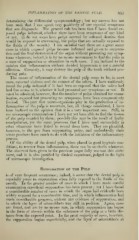Page 843 - My FlipBook
P. 843
INFLAMMATION OF THE DENTAL PULP. 853
deteriuining the diiferential symptomatology ; but my success has not
been such that I can speak very positively of any especial symptoms
that are diagnostic. The general rule has been that I have found ex-
posed pulps inflamed, whether there have been symptoms of any kind
or not. (I do not mean here pulps covered by softened dentine that
would be exposed in excavating, but pulps that are actually exposed to
the fluids of the mouth.) I am satisfied that there are a great many
cases in which exposed pulps become inflamed and go on to suppura-
tion and the final destruction of the organ without presenting any symp-
toms whatever; indeed, it is by no means uncommon to find the pulj) in
a state of suppuration or ulceration in such cases. I am inclined to the
opinion that inflammation without decided hyperemia is not a painful
affection. Certainly, it may destroy the pulp of the tooth without pro-
ducing pain.
The causes of inflammation of the dental pulp seem to be, in most
cases, external violence and the contact of the saliva. I have uniformly
found the pulp inflamed if it had been so exposed that the saliva had
had free access to it, whether it had presented any symptoms or not. It
must be admitted, however, that the number of pulps obtained for exam-
ination, exposed but presenting no symptoms, have been comparatively
limited. The part that micro-organisms play in the production of in-
flammation of the pulp is uncertain, but, all tilings considered, I have
been inclined to the opinion that it is a very important one. Still, in
my microscopic examinations I have not yet been able to find the tissues
of the pulp invaded by them possibly this may be the result of faulty
;
manipulation, yet the same processes that I have used successfully in
other situations have failed to reveal them here. They are plentiful,
however, in the pus from suppurating pulps, and undoubtedly their
waste products have much to do with the initiation of the inflammatory
process.
Of the ability of the dental pulp, when placed in good hygienic con-
ditions, to recover from inflammation, there can be no doubt whatever.
The observed facts given in the previous pages fully warrant this state-
ment, and it is also justified by clinical experience, judged in the light
of microscopic investigation.
Suppuration op the Pulp
is of very frequent occurrence ; indeed, it seems that the dental pulp is
especially prone to suppuration when fully exposed to the fluids of the
mouth. In the greater number of cases in -which I have made careful
examination suj^erficial suppuration has been present ; yet I have found
a considerable number of cases in which the organ had evidently been
widely exposed for a considerable time, and in which inflammation had
made considerable progress, without any evidence of suppuration, and
in which the layer of odontoblasts was still in position. Again, cases
are found, and are by no means rare, in which suppuration has begun
in the form of abscess within the substance of the pulp at a little dis-
tance from the exposed point. In the great majority of cases, however,
the suppuration begins superficially, and the layer of odontoblasts at


